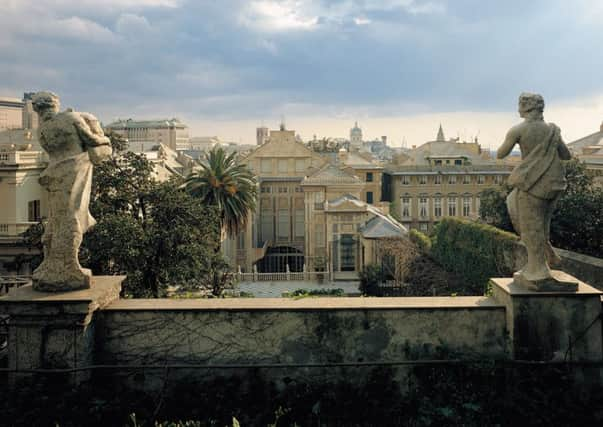Travel review: Genoa - a ligurian labyrinth


I’m lost in Genoa, wandering through an intriguing labyrinth of ancient cobblestone alleyways so narrow no sunlight can penetrate. Adding to my happy confusion is the feeling that I’ve stepped back in time and, in a way, I have. These lanes, known as the caruggi, claim to be the birthplace of Christopher Columbus – the city’s most famous son, and are part of Europe’s largest medieval town.
This Unesco world heritage site, tucked behind a bustling modern port, is redolent with history and atmosphere, and just one of the gems in a fascinating destination all too often overlooked in favour of Italy’s big hitters, Rome, Florence and Venice.
Advertisement
Hide AdAdvertisement
Hide AdAutumn’s an ideal time to visit because cruise crowds have, in the main, evaporated and it’s possible to relax and really appreciate a place Charles Dickens, who spent a year living here, aptly described as a “beautiful confusion” with so much crammed into a thin snaking 30km strip of land, squashed between hills and the Mediterranean Sea.
One of the shopkeepers in the old town, who comes to my rescue with directions, sums up the essence of this capital of the beautiful Liguria region (around 100 miles north east of the French border). “Getting lost in Genoa is easy but is surely one of the city’s pleasures, because you never know what you’ll find; there are surprises around every corner,” says Alessandro Boccardo, the smiling owner of a chocolate shop founded in 1866, which still has the original 19th century machines used to roast cocoa beans.
His store, Romeo Viganotti (on Vico dei Castagna), is just one of 36 artisan shops housed in centuries-old buildings, some still boasting pillars, statues and frescoes from grander days. Here, traditional practices, including tripe-making, have been carried on for generations.
Tripe? Yes, surprisingly this is a favourite snack for schoolchildren who scurry past holding cardboard cones filled with the stuff, an alternative to their other treat, focaccia, the delicious local flatbread.
Advertisement
Hide AdAdvertisement
Hide AdWhile the Centro Storico district is charming, it’s impossible not to be impressed by the spectacular Rolli Palaces on the Via Garibaldi, dubbed “the street of kings” – each one more lavish than the last. Three virtually combine to become one huge museum and boast stunning frescoes and artworks by masters such as Caravaggio, Rubens, Titian, van Dyck, Gauguin and Veronese.
An exhibition, From the Impressionists to Picasso, is the main draw at the Palazzo Ducale to April 10, and will feature works by Monet, Degas and van Gogh (entry 15 euros; palazzoducale.genova.it).
Another treasure is the magnificent Cathedral of San Lorenzo, which contains the ashes of St John the Baptist. Its striking exterior of black and white marble is characteristic of so many buildings throughout the city. I touch a tiny dog carved into its marble pillars, which is supposed to bring luck.
Lack of space made the Genoese resourceful. To give an impression of majesty and status, they skilfully employed trompe l’oeil painting techniques, and fascias of many buildings are embellished with “faux” marble pillars, porticos and arches, giving them an elegant theatrical character.
Advertisement
Hide AdAdvertisement
Hide AdDespite a reverence for the past, this is still very much an authentic working city, where port workers mingle with bankers and tourists.
To get my bearings, I take a bird’s-eye view. The city was built in steep tiers like a wedding cake, but I avoid an exhausting climb by using the Art Nouveau lift at Piazza del Portello, up to Spianata Castelletto (0.90 euros). I enjoy a vista stretching from the mountains to the Mediterranean.
Eating and drinking is a serious pastime and I learn one key Genoese phrase “mescite” (hurry up and pour) as I visit a few of Genoa’s cosmopolitan wine bars. One ingredient is also ubiquitous on the restaurant menus – pesto, which originated in the area.
Roberto Panizza, who helps organise the annual Genoa Pesto World Championship, gives me a lesson in making it and sums up his birthplace. “While the port’s still the soul of Genoa, this is a multi-faceted city which has so many layers. It takes time to understand it but it’s worth it,” he says. And I couldn’t agree more.
GETTING THERE
Advertisement
Hide AdAdvertisement
Hide AdMelia Genova (www.melia.com), doubles from £85 per night with breakfast. For a tranquil retreat in a central location, the Melia hotel, on quiet tree-lined Via Corsica, is an excellent choice and close to landmarks such as the medieval gates and the city’s cathedral of San Lorenzo.
The building’s imposing art deco exterior was originally designed in 1929, but the interior and facilities are impressively modern.
Art, one of the biggest attractions for the city’s visitors is reflected in its decor, with displays of installations and photographs by internationally acclaimed Italian artists.
Service falls into the “can’t do enough for you” category and staff members are ready and willing to share useful local knowledge.
Advertisement
Hide AdAdvertisement
Hide AdGabrielle Fagan was a guest of the Genoa tourist board. Visit www.visitgenoa.it/en/ and www.turismoinliguria.it/en/
Return flights from Gatwick to Genoa start from £81 return with British Airways (britishairways.com).